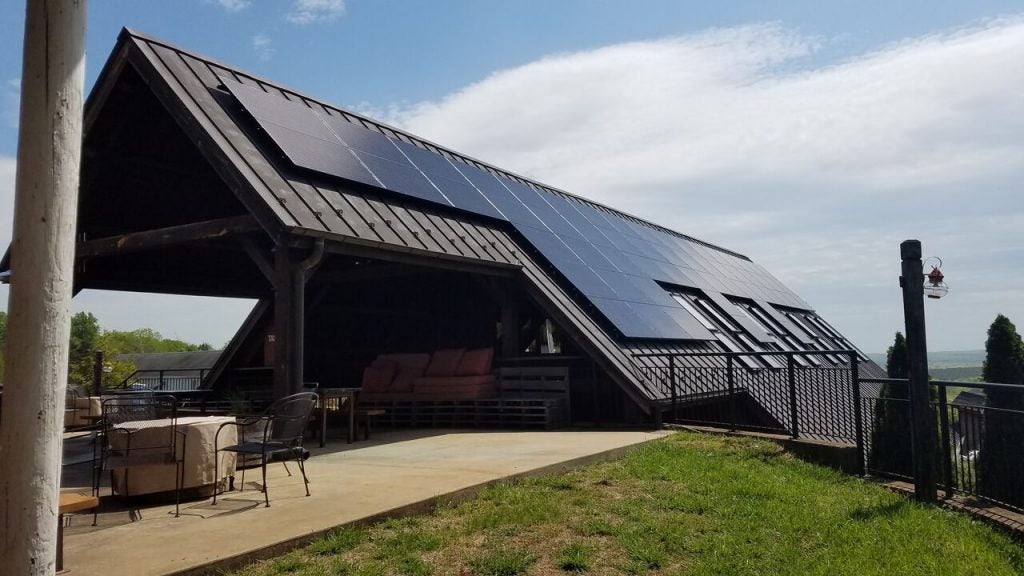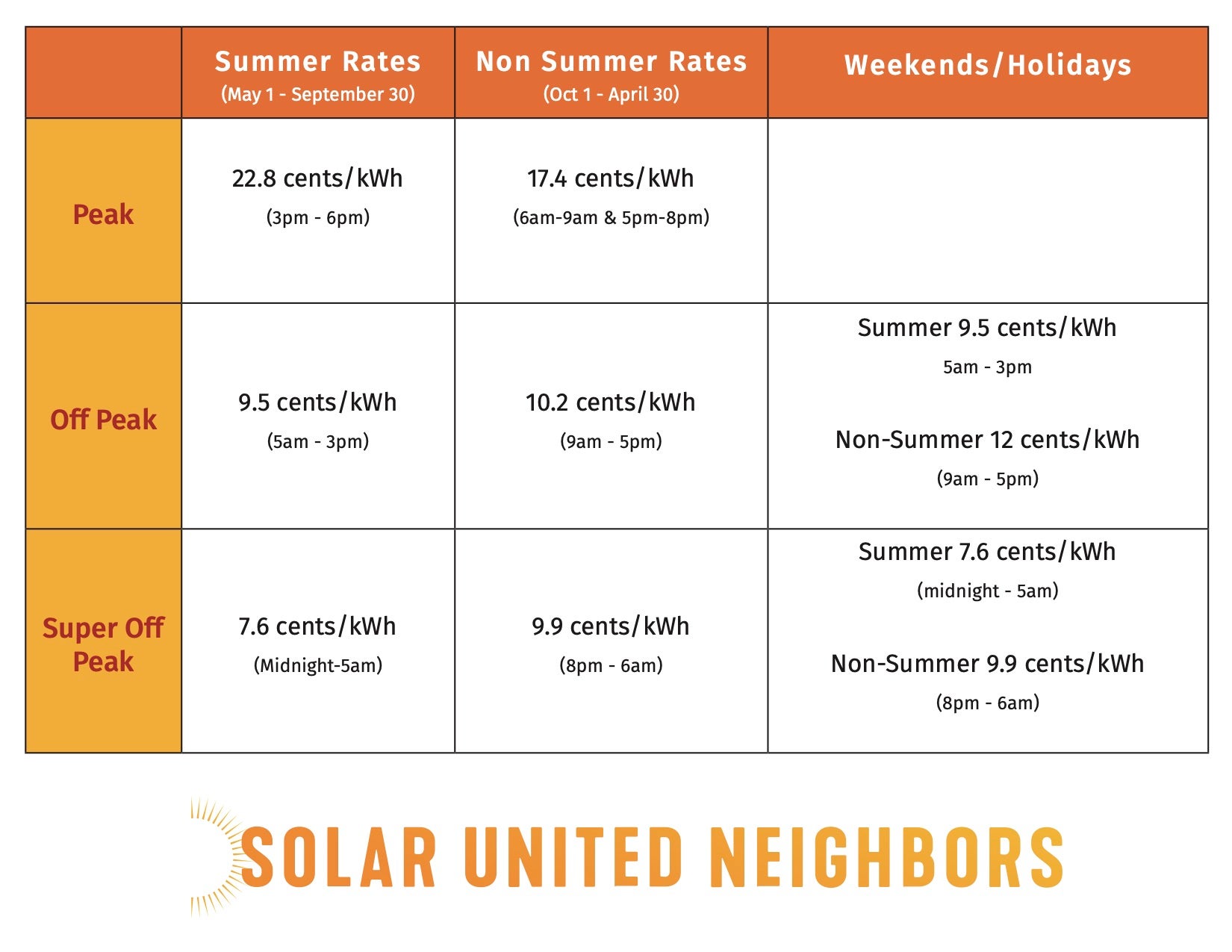What Dominion’s Time of Use plan means for solar owners

If you live in Dominion Energy service territory you may have a new option for how you are charged for the electricity you use. This new rate is called time-of-use (TOU). This new rate structure (also called a tariff) may provide benefits to some solar owners. It could also benefit you if you have battery storage or an electric vehicle. Let’s look at how.
What is Time-of-Use?
Most of us pay the same amount for the electricity our home uses regardless of when we use it. Time-of-use rates can vary according to the time of day, season, and even the kind of day (for example, weekday vs. weekend).
Under a time-of-use rate structure, the price you pay for electricity goes up at times when the demand for electricity is high. It goes down when the demand for electricity is low. The chart below gives an example of Dominion’s time-of-use pricing.

The average fixed rate for electricity for a residential Dominion customer is 11.4¢/kWh. Under time-of-use, you would pay less than that most of the time. But, you would pay more for electricity used during peak times.
In addition to the rates per kWh described above, the fixed customer charge on this plan remains the same, $6.58/month. It applies no matter how much energy you use or when you use it.
Customers that go solar after signing up for this plan also receive a one-time $500 incentive payment.
If I have solar, is this TOU plan good for me?
This time-of-use tariff can benefit you if you have or are thinking about getting technologies like solar, EV charging, and battery storage.
It can also save you money if you are willing to change when you use electricity. These changes can come either through behavior change or through the use of hardware and software tools. Here are general advantages and disadvantages of this plan:
Advantages:
- You can save money by changing behavior or using advanced technology (like EV charging, smart thermostats and appliances, and battery storage).
- You may earn more value from west-facing solar panels.
- You’ll pay less to fuel electric vehicles when you charge them during off-peak or super off-peak hours.
- You may be able to use your battery system to store electricity when it is less expensive and discharge during more expensive ‘peak’ times.
- Your use of less electricity during peak periods has environmental and cost saving benefits for all utility customers.
Disadvantages:
- You will earn less from net metering if you have south- or east-facing solar.
- You may require significant changes in behavior and need to pay more attention to when and how you use electricity.
- You may not find it valuable if you don’t have home energy monitoring technology or ‘smart appliances’ like programmable thermostats.
Is the TOU plan better for some solar arrays than others?
Bottom line: You’ll likely see some extra solar savings with this plan if your solar array faces west. If your array faces south or east, you’ll probably see a slight loss in solar savings.
Solar systems that face west generate more electricity during the afternoon and early evening hours. This is when time-of-use rates are higher. The electricity you generate then is more valuable.
We estimate that systems with panels that face east and south would take longer to pay back under TOU than they would under the current rate. Systems that face west will likely have a slightly shorter payback period under TOU.
If you aren’t sure whether your array is oriented the right way to take advantage of this tariff, check with your installer or with Solar United Neighbors.
What about this plan and EV charging?
Bottom line: Charging your EV during off-peak and super off-peak times can save you money.
You could save money on this plan by setting your electric vehicle (EV) to charge during off-peak and super off-peak hours. This will reduce the $/mile you pay. The super off-peak rate is $0.076 (summer) to $0.099/kWh (non-summer). Both of these rates are less than the cost of electricity for the standard residential plan. For example, if you only charged your EV during the super off-peak period you can save an average of 24% throughout the year.
Will batteries help?
Bottom line: Time-of-use could provide you with some added savings.
If you have batteries for resiliency, you may also be able to use them to save money. Depending on the technology and design of your storage system, your batteries can be programmed to store electricity when it is less expensive. You can then use that stored electricity when grid electricity is expensive (during the peak).
When combined with solar, this might mean charging your batteries up during the day from the sun and then discharging them in the early evening or morning times when grid electricity is more expensive. The value from this won’t pay for your batteries. But, it does offer the opportunity to derive value from batteries that would otherwise be idle, waiting for the power to go out.
Whether you can use your batteries for this depends on your battery technology, system design, and the attached inverter’s capabilities. Lithium-ion batteries are better suited than lead-acid batteries. However, frequent discharge of any battery technology may shorten their life. Further, some inverters may not have software capable of handling this kind of usage.
What else should I consider if I’m on this plan?
Bottom line: Changing usage patterns through behavior changes and/or technology can save you money.
Besides solar, EV charging, and batteries, there are other ways to maximize participation in this plan. You can also see electricity savings with changes to when you use electricity if they line up with off-peak and super off-peak periods. You can do this with behavior changes.
This might mean only using heavy appliances like dishwashers and dryers during weekends or off-peak times. You can also save money by using smart appliances and thermostats (EcoBee and Nest, for example) to prioritize energy usage during off-peak periods.
Dominion is running time-of-use as a pilot program. The utility will be accepting feedback from participants. If you sign up, let them know how it’s going. This will help them improve this plan in the future. We’d love to hear from you too!
Visit Dominion’s website to learn if you are eligible to participate.
